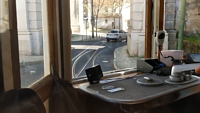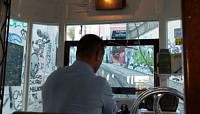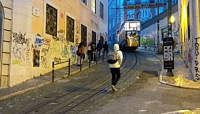Lightweight trams were later introduced (there are pictures in the museum section) but didn't survive the constant pounding from passengers and the network of hills and tight bends so when in
1990 there was another major reconstruction of the network, the historic remodelado trams with re-fitted with new engines, brakes and electronics. Since the design was
now unique to the Lisbon tramway, the trams were re-named as "Portuguese Remodelado". I have created an animated map showing the development in the network between 1959 and 2018.
More good news in 2018, route 24E was re-instated having been suspended 24 years earlier. Route 24E first opened in 1905 was re-opened in April
2018 running from Campolide to (for the time being) Praça Luís De Camões where it connects with route 28E. The route originally terminated at the Cais do Sodre and I believe that will be the final
destination but at the time of writing (March 2019) there is still some trackwork that needs completing to complete the route. The route also connects with the funicular Ascensor da Glória.
This "new" sixth route isn't mentioned much in the guide books when I visited in 2019 so you'll probably have no problem in getting a seat! I have created an animated map showing the development in the network between 1959 and 2018.
Navigation: Brief history, Current network, Tram photos
, Videos, Funicular railway, Transport museum, Traveler tips
, Top
Tram photographs:
Please scroll down through the photos of the remodelado trams.
.jpg)
Circular route E12 rounding the bend to Praça da Figueira
.jpg)
Route E12 is the shortest route on the system. It runs through the very busy Alfama
district removing some of the load from the busiest route on the network, the E28.
.jpg)
Not so yellow - extra revenue is made from advertising!
.jpg)
A nice view of a route 24E tram approaching the start of the route at Camões.
.jpg)
A nice street view.
.jpg)
The turning point at Estrela where the red tourist trams and some 28E trams on a slightly shorter route start their return trip.
.jpg)
An interior view of the rear of a remodelado tram.
.jpg)
And an interior view looking forward.
.jpg)
A view of the Praça da Figueira where routes 24E and 15E terminate (with the 12E also calling).
.jpg)
The red trams are run as a tourist hop-on hop-off service and are relatively expensive to ride. They share the tracks with the Carris (yellow) trams but use their own single circular route.
.jpg)
Information posters urging road users to be considerate ......
.jpg)
.... but many are not. The tram driver here was worried that the footplate would damage this car's wheel / tyre.
.jpg)
A cafe / bar made from an old tram in Belem.
.jpg)
I didn't visit as I'd just had a coffee elsewhere but will next time I'm in Lisbon.
.jpg)
More red trams in Alfama.
.jpg)
Evening approaches.
.jpg)
There are lots of restaurants in this area of Alfama.
.jpg)
Finally the 28E service tram, appears!.
.jpg)
A night view of a 28E tram in Camões.
.jpg)
The service remains busy through the evening!
.jpg)
The remodelado dashboard.
.jpg)
Compolide, the terminus of the 24E route (re-introduced in 2018 after 24 years).
.jpg)
Lot's going on here; lucky these trams have good brakes!
.jpg)
These older, vintage trams (which make up most of the fleet on all but one route) date from the 1930's
although with new motors and control gear fitted in the 1970's.
.jpg)
The trams draw up to 50 kW at 600 volts. The track gauge is 900 mm (a fraction under 3 foot) which is classified as narrow gauge.
.jpg)
.
.jpg)
The castle can be seen in the background. This is the terminus of 28E.
.jpg)
.
.jpg)
While at the Compolide terminus, a bus rounded the corner and it's wing mirror hit the rear window panel.
.jpg)
The panels are safety glass - it made quite a bang as the glass shattered but no one was injured although the driver of the bus appeared quite shaken.
.jpg)
Route 28E about 6 minutes from its terminus.
.jpg)
.
.jpg)
This view at the top of the Elevador da Glória (elevator/funicular).
.jpg)
Route 24E at the Principe Real park.
.jpg)
.
.jpg)
The start of route E24 at Camoes in March 2019. The route will eventually extend to the Cais do Sodre once repairs to the tracks are completed.
.jpg)
Another 24E near the Principe Real park.
.jpg)
.
.jpg)
The terminus of the E28 at Martim Moniz.
.jpg)
.
.jpg)
A busy area at Camoes - the 28E runs through here while the 24E terminates.
Navigation: Brief history, Current network, Tram photos
, Videos, Funicular railway, Transport museum, Traveler tips
, Top
Funicular railways:
Please scroll down through the photos of the funicular railway (elevator). My photos are currently limited to just one railway.
.jpg)
A view at the top end of the "Ascensor da Glória" funicular railway. The area is a showcase for street art.
.jpg)
Another view of the top of this short railway. Dating back to 1885 and originally water powered, the tram was converted to
electrical power with the current two cars in 1914.
.jpg)
A view inside the car showing the drivers' position. The engines / compressors are Maley 234s.
.jpg)
A closer view of the controls.
.jpg)
Another view of the control gear.
.jpg)
A dramatic view at the bottom end! The two tracks here (one dedicated to each car) overlap. The route is from Praça Restauradores to S. Pedro de Alcântara (shown here)
along the Calçada da Glória. The Ascensor da Glória was declared a National Monument in 2002.
.jpg)
A plaque on the wall of the tram celebrating the Centenary in 1985.
.jpg)
An evening view inside the car.
.jpg)
A view through the rear window.
Navigation: Brief history, Current network, Tram photos
, Videos, Funicular railway, Transport museum, Traveler tips
, Top
Transport museum:
As well as the static exhibits, a visit to the transport museum gives you a short ride on one of the historic
trams. The museum is adjacent to the Santo Amaro depot. Tram route 15E stops outside while route 18E stops within 200 meters.
.jpg)
A horse-drawn tram dating from 1873.
.jpg)
A model of one of the lightweight trams that sadly, didn't survive the pounding they got in Lisbon!
.jpg)
Tram interior from one of the trams in the museum.
.jpg)
Control panel.
.jpg)
The driver was outside and would have got wet in the rain and cold in the winter.
.jpg)
An open-air version!
.jpg)
This chassis shows just how small the wheelbase is.
.jpg)
A tram in the museum grounds (which share space with the operational tram depot).
.jpg)
Another interior view.
.jpg)
Another view inside the depot.
.jpg)
A dramatic view outside the museum / depot showing one of the massive bridge support towers.
Navigation: Brief history, Current network, Tram photos
, Videos, Funicular railway, Transport museum, Traveler tips
, Top

.jpg)








.jpg)
.jpg)
.jpg)
.jpg)
.jpg)
.jpg)
.jpg)
.jpg)
.jpg)
.jpg)
.jpg)
.jpg)
.jpg)
.jpg)
.jpg)
.jpg)
.jpg)
.jpg)
.jpg)
.jpg)
.jpg)
.jpg)
.jpg)
.jpg)
.jpg)
.jpg)
.jpg)
.jpg)
.jpg)
.jpg)
.jpg)
.jpg)
.jpg)
.jpg)
.jpg)
.jpg)
.jpg)
.jpg)
.jpg)
.jpg)
.jpg)
.jpg)
.jpg)
.jpg)
.jpg)
.jpg)
.jpg)
.jpg)
.jpg)
.jpg)
.jpg)
.jpg)
.jpg)
.jpg)
.jpg)
.jpg)
.jpg)
.jpg)
.jpg)
.jpg)
.jpg)





 websites
websites